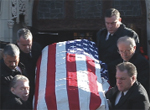 Many readers of this newspaper knew Bob Schubert as the fierce combatant who took his fight over the destruction of a pond on his property to the councils and committees of the City of Rye, as well as to the courts of justice and public opinion. His advocacy was not always polite, and the ferocity of his verbal attacks sometimes seemed offensive to those on the receiving end.
Many readers of this newspaper knew Bob Schubert as the fierce combatant who took his fight over the destruction of a pond on his property to the councils and committees of the City of Rye, as well as to the courts of justice and public opinion. His advocacy was not always polite, and the ferocity of his verbal attacks sometimes seemed offensive to those on the receiving end.
By Bob Marrow
Many readers of this newspaper knew Bob Schubert as the fierce combatant who took his fight over the destruction of a pond on his property to the councils and committees of the City of Rye, as well as to the courts of justice and public opinion. His advocacy was not always polite, and the ferocity of his verbal attacks sometimes seemed offensive to those on the receiving end.
In the last weeks of his life, he agreed to be interviewed in order reassert his rights against those who turned his lovely Forest Avenue pond into a field of mud.
 But there is much more to Bob Schubert than “the pond controversy.”
But there is much more to Bob Schubert than “the pond controversy.”
Born in 1923, he was old enough to serve our country at the outset of World War II; but his expertise as a mechanical engineer — he received an engineering degree from Columbia University after graduating from DeWitt Clinton High School — resulted in a deferment from the draft. In 1943, he was assigned to work for the Chrysler Corporation designing engines, particularly for tanks. But three months of peaceful toil in the offices and laboratories of Chrysler was more than he could bear while others were fighting. Mr. Schubert applied for, and received, a commission as an officer in the Navy.
He was assigned to officer preparation school at Princeton University, where he was trained as an engineering officer whose duties would be to maintain and repair naval equipment aboard ship, from engines to armament. After Princeton, he received special training in diesel engines at Cornell, and was then assigned to the Landing Craft Base at Little Creek, Virginia, part of the Norfolk Navy Yard complex.
Mr. Schubert was assigned to LSM-441 (Landing Ship Medium), a mid-size craft that carried troops and heavy equipment onshore. The LSM-441 was 158 feet long, 35 feet wide, with twin diesel engines, each with 1800 horsepower, which could speed the ship up to 18 knots. The ship carried a crew of 100, usually ten officers and 90 enlisted men. LSM-441 sailed from Little Creek, Virginia through the Panama Canal to a base in California, and then to Hawaii where it joined a convoy to the Mariana Islands, including Guam and Saipan.
His ship participated in numerous landings under fire during the eight months in the Marianas. As engineering officer, he was responsible not only for keeping the twin 1800-hp diesel engines operating properly, but also for ensuring that the bow doors and ramps operated smoothly so troops and equipment could be off-loaded swiftly. Ships close to Mr. Schubert’s, as they approached and backed off the beaches, were blown out of the water under withering Japanese artillery attacks. But his LSM-441 survived intact; he was not wounded. It is not an exaggeration to say that the successful landings by U.S. forces on the beaches of the Pacific were made possible because of the competence, efficiency, and courage of naval officers like Bob Schubert.
When the war ended in August 1945, he was made commanding officer of his ship, although his rank remained Lt. JG; and he returned with the LSM-441 to California. Mr. Schubert was released from active duty, but remained in the regular USN (not the Reserves) in a special group that worked on engineering and technical projects.
Mr. Schubert returned to a civilian position as Chief Engineer under a Navy contract with Columbia University. He was involved in pure scientific research: building and operating an atomic particle accelerator known as a cyclotron. The Columbia University cyclotron was dedicated personally by President Eisenhower in nearby Ardsley in a laboratory known as Nevis, the Caribbean Island birthplace of Alexander Hamilton. It has only recently been torn down.
Later in his career at Columbia, Mr. Schubert was part of a group of five carefully selected engineers studying and developing the best possible computer for the Navy. It was the size of an average suburban house and was called NORC (Naval Ordinance Research Calculator). Since the Navy and IBM had research contracts with Columbia, it was natural that the teams of engineers and scientists got to know each other. IBM became interested in the Navy’s NORC research, seeing it as a substantial step in the development of the IBM mainframe computers.
Mr. Schubert was asked by IBM to work on various projects, one of which involved the development of prosthetic joints for the human body. Later, in the early 1950’s, he accepted a position as the engineer in charge of IBM’s main laboratory in Poughkeepsie. After IBM moved its engineering headquarters to 57th Street in New York City, Mr. Schubert became Director of Product Test for the company’s laboratories worldwide, outside of the United States. He was transferred to Europe, where he worked with NATO’s Air Defense Ground Environment (NADGE), which was a system similar to the defensive DEW Line in the United States and Canada. He spent nine years in Europe working for IBM in conjunction with NATO.
During this period IBM scientists and engineers were coming up with great ideas for building and using their computers in novel ways and environments. Mr. Schubert worked closely with the office of the chairman, reporting on recommendations for the use of products under development. IBM scientists and engineers would submit the ideas, arguments, plans and/or test results showing what could be done, and his PTF team would confirm whether the plans could be practically accomplished. The result was that IBM would only sell computers that could actually be built and would work effectively for the proposed purpose.
Mr. Schubert retired from IBM in the late 1970s after a career spanning three decades.
His life in engineering left him with the point of view that everything has or should have a logical cause and effect. That is why, as he approached his 90th year, he remained intensely focused on the “pond controversy” at his gracious home on Forest Avenue.
“My beautiful pond, part of a wetland shown on maps that are 150 years old, was turned into an ugly mud field by human action — yet no one can be held responsible. How can that be?” he asked.
It is sad yet understandable that a man of science continued to wonder at this apparently illogical conclusion in the last years of his life. He passed away January 5.
—Photo by Andrew Dapolite















